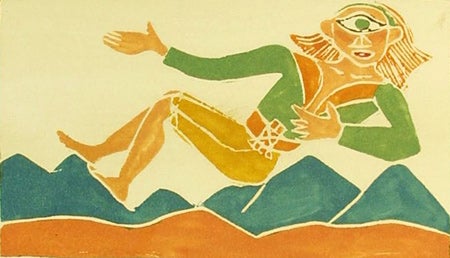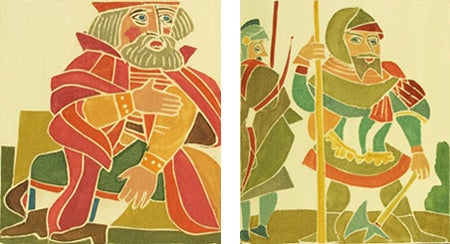

The Horrible and Terrifying Deeds and Words of the Very Renowned Pantagruel King of the Dipsodes, Son of the Great Giant Gargantua (better known as simply Pantagruel) was the first in a series of five satirical books by the Franciscan monk and physician François Rabelais chronicling the outrageous adventures of the giants Gargantua and Pantagruel and friends. Published around 1532, Pantagruel is rife with vulgarity, scatological humor, and violence. In spite (or possibly because) of being condemned by the church and deemed obscene by the censors of the Sorbonne, the books proved very popular. In testimony to the author’s continuing influence, Merriam-Webster defines Rabelaisian as “marked by gross robust humor, extravagance of caricature, or bold naturalism.”
In the late 1930s, André Derain was commissioned by Swiss publisher Skira to illustrate Pantagruel. Inspired by medieval hand-colored playing cards, the artist created more than 128 woodcuts to illustrate the story. Derain, who by this time was painting in a traditional realist vein, returned to the exuberant colors of Fauvism, the movement he had co-founded decades earlier. Instead of using separate blocks for individual colors, each illustration was printed from a single block with all colors applied simultaneously (a process known as à la poupée), a method so rigorous that it took two years to print an edition of 275. The book was released in 1943 and became a highlight in the history of modern illustrated books.

Artstor is the only online source for all 128 illustrations, the cover, and a hand-drawn frontispiece, courtesy of the Fine Arts Museums of San Francisco Collection; search for Pantagruel and Derain to find them. From the same collection, you may also be interested in Gustave Doré’s fulsome illustrations for a 19th century edition of Oeuvres de Rabelais (search for Dore and Rabelais), or Derain’s primitivist woodcut illustrations for L’Enchanteur Pourrissant, Guillaume Apollinaire’s first collection of poetry from 1909 (search for Derain and Apollinaire).


